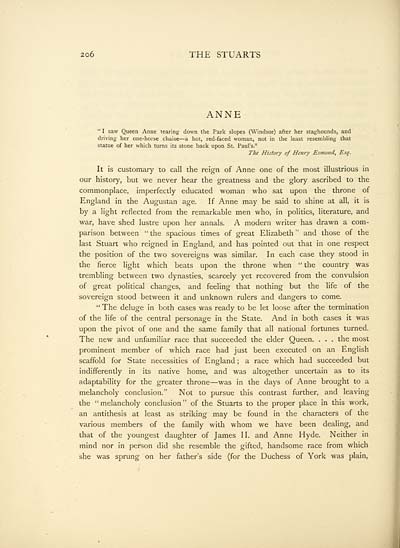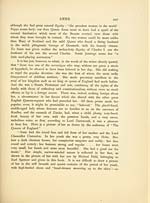Stuarts
(270) Page 206
Download files
Complete book:
Individual page:
Thumbnail gallery: Grid view | List view

2o6 THE STUARTS
ANNE
" I saw Queen Anne tearing down the Park slopes (Windsor) after her staghounds, and
driving her one-horse chaise — a hot, red-faced woman, not in the least resembling that
statue of her which turns its stone back upon St. Paul's."
The History of Henry Esmond, Esq.
It is customary to call the reign of Anne one of the most illustrious in
our history, but we never hear the greatness and the glory ascribed to the
commonplace, imperfectly educated woman who sat upon the throne of
England in the Augustan age. If Anne may be said to shine at all, it is
by a light reflected from the remarkable men who, in politics, literature, and
war, have shed lustre upon her annals. A modern writer has drawn a com-
parison between "the spacious times of great Elizabeth" and those of the
last Stuart who reigned in England, and has pointed out that in one respect
the position of the two sovereigns was similar. In each case they stood in
the fierce light which beats upon the throne when " the country was
trembling between two dynasties, scarcely yet recovered from the convulsion
of great political changes, and feeling that nothing but the life of the
sovereign stood between it and unknown rulers and dangers to come.
" The deluge in both cases was ready to be let loose after the termination
of the life of the central personage in the State. And in both cases it was
upon the pivot of one and the same family that all national fortunes turned.
The new and unfamiliar race that succeeded the elder Queen. . . . the most
prominent member of which race had just been executed on an English
scaffold for State necessities of England ; a race which had succeeded but
indifferently in its native home, and was altogether uncertain as to its
adaptability for the greater throne — was in the days of Anne brought to a
melancholy conclusion." Not to pursue this contrast further, and leaving
the "melancholy conclusion" of the Stuarts to the proper place in this work,
an antithesis at least as striking may be found in the characters of the
various members of the family with whom we have been dealing, and
that of the youngest daughter of James II. and Anne Hyde. Neither in
mind nor in person did she resemble the gifted, handsome race from which
she was sprung on her father's side (for the Duchess of York was plain,
ANNE
" I saw Queen Anne tearing down the Park slopes (Windsor) after her staghounds, and
driving her one-horse chaise — a hot, red-faced woman, not in the least resembling that
statue of her which turns its stone back upon St. Paul's."
The History of Henry Esmond, Esq.
It is customary to call the reign of Anne one of the most illustrious in
our history, but we never hear the greatness and the glory ascribed to the
commonplace, imperfectly educated woman who sat upon the throne of
England in the Augustan age. If Anne may be said to shine at all, it is
by a light reflected from the remarkable men who, in politics, literature, and
war, have shed lustre upon her annals. A modern writer has drawn a com-
parison between "the spacious times of great Elizabeth" and those of the
last Stuart who reigned in England, and has pointed out that in one respect
the position of the two sovereigns was similar. In each case they stood in
the fierce light which beats upon the throne when " the country was
trembling between two dynasties, scarcely yet recovered from the convulsion
of great political changes, and feeling that nothing but the life of the
sovereign stood between it and unknown rulers and dangers to come.
" The deluge in both cases was ready to be let loose after the termination
of the life of the central personage in the State. And in both cases it was
upon the pivot of one and the same family that all national fortunes turned.
The new and unfamiliar race that succeeded the elder Queen. . . . the most
prominent member of which race had just been executed on an English
scaffold for State necessities of England ; a race which had succeeded but
indifferently in its native home, and was altogether uncertain as to its
adaptability for the greater throne — was in the days of Anne brought to a
melancholy conclusion." Not to pursue this contrast further, and leaving
the "melancholy conclusion" of the Stuarts to the proper place in this work,
an antithesis at least as striking may be found in the characters of the
various members of the family with whom we have been dealing, and
that of the youngest daughter of James II. and Anne Hyde. Neither in
mind nor in person did she resemble the gifted, handsome race from which
she was sprung on her father's side (for the Duchess of York was plain,
Set display mode to:
![]() Universal Viewer |
Universal Viewer | ![]() Mirador |
Large image | Transcription
Mirador |
Large image | Transcription
Images and transcriptions on this page, including medium image downloads, may be used under the Creative Commons Attribution 4.0 International Licence unless otherwise stated. ![]()
| Histories of Scottish families > Stuarts > (270) Page 206 |
|---|
| Permanent URL | https://digital.nls.uk/95242291 |
|---|
| Description | A selection of almost 400 printed items relating to the history of Scottish families, mostly dating from the 19th and early 20th centuries. Includes memoirs, genealogies and clan histories, with a few produced by emigrant families. The earliest family history goes back to AD 916. |
|---|

